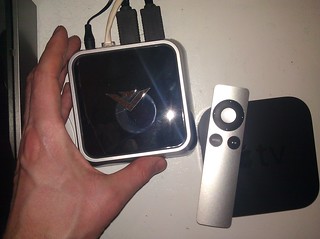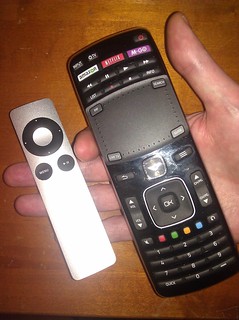What kind of crazy person buys both a Vizio Co-Star (Google TV) and an Apple TV?
Apparently, I’m that kind of person.
I’ve had the Vizio Co-Star for 3 months, and the Apple TV just for a couple days. Maybe that’s a source of bias, but the summary version is, despite its shortcomings, I think Vizio Co-Star provides a superior experience.
Now for the long version:
Both the Vizio Co-Star and Apple TV are inexpensive ($100) set-top boxes: small footprint devices that promise to deliver networked multimedia to your television set. Movies, music, TV shows, sports, photos, and more now on the big screen in your living room. Both can connect wirelessly, although both also have ethernet ports. Both deliver 1080p HD via HDMI.
My biggest point of frustration with the Vizio Co-Star is the remote control. It has a full TV remote on one side, and a QWERTY keyboard on the other.
The QWERTY keyboard is frustrating. Its soft rubber keys require serious mashing and don’t provide enough tactile feedback–sometimes you think you’ve typed something only to look up at the screen to discover it didn’t register. It would be nice if there was an option to provide audio feedback while you’re typing, but the accessibility option (the Android app TalkBack) is overkill if that’s all you’re looking for.
You can connect other keyboards to the Co-Star, although my attempts to use a USB keyboard have been unsuccessful so far. I may have better luck with a Bluetooth keyboard. I have installed a couple different remote apps on my Android phone, which are interesting but have not been entirely satisfactory. There is also a game controller available for the OnLive service, which I have not yet explored.
The Apple TV remote is as you might expect from Apple: sleek, slim, and simple. Unfortunately, there were several things about the Apple TV remote experience that I did not like:
- It’s too small! A handheld device should fit the hand and be easy to grasp.
- It frequently triggered the FrontRow feature on my nearby Mac. Although there is a way to pair a device to a specific remote, there is no way to pair a remote to a specific device. Of course, I could get a second remote for my Mac Mini….
- It requires line-of-sight (the Co-Star remote uses Bluetooth in addition to IR, so line-of-sight is not necessary once configured.
- The remote controls only the Apple TV. The Co-Star remote acts as a universal remote and can control the Google TV features as well as the TV set, the cable, and some features of my stereo receiver.
Winner: Vizio Co-Star, but with some serious reservations.
Streaming Content
The Vizio Co-Star has 2 HDMI ports: in for your cable, and out for your television. This means that your cable is now fully integrated with your Google TV experience. You can browse shows and On-Demand the same way you did before, but now you also have an integrated search feature. Let’s say you want to watch Sherlock–you search for Sherlock and discover that it’s streaming on Netflix, you can buy it on Amazon Instant Video, and it is not currently playing on TV. If you search for Doctor Who, you’ll find out when it next airs on BBC America, or even if it is playing now.
Viewing options include:
- Cable
- Netflix
- Amazon Instant Video
- Google Play
- YouTube
By contrast, Apple TV does not integrate with your cable. It also does not access Amazon Instant Video. But if you’re a serious cord-cutter, Apple TV does offer:
- Netflix
- Hulu Plus
- YouTube
- iTunes Store
- A variety of for-pay sports channels (MLB, NBA, NHL)
Unless you’ve done away with cable entirely, the cable pass-through feature of the Vizio Co-Star is a huge advantage.
Winner: Vizio Co-Star
Your Network Content
Both integrate with iTunes on your local network. You might guess that the Apple TV’s integration is more seamless. However, the main menu items on the Apple TV want you to sign up for the iTunes Match service ($25/year) which basically gives you cloud access to your iTunes account’s purchases. You can only access your iTunes library after using the HomeSharing feature and logging in with the same Apple ID. (An unnecessary step on the Vizio.)
I had heard rumors that the Plex Media Server was going to change everything as far as these set-top boxes go, so I installed it on my Mac Mini. It is fairly easy to configure, but I have had to check the log files to troubleshoot it several times, so it’s not something I’d recommend for everyone. (On the other hand, that may be because I store my media files on a NAS device. Apparently, newer NAS devices can run Plex directly, which may be easier.) So from the Vizio Co-Star I can access my entire digital media catalog, as well as anything I happen to have in iTunes. You can download Plex for Google TV, or PlayPoint comes pre-installed.
Apple TV can additionally access all the podcasts and iTunes radio stations that are available through iTunes (the Vizio Co-Star cannot access these–it can only access iTune’s downloaded content). Although you can apparently install Plex on a jailbroken Apple TV, I decided not to do that.
In either case, it means that you have to leave the source computer running. I’m the sort of person who likes to turn my computer off when I’m not using it.
Winner: Tied. Both could do better.
Accessing the Web: Chrome and AirPlay
Accessing the web is an important feature for me. For example, lately I’ve been watching lectures and instructional videos on services like Lynda and Coursera. What better way than to check these out on a nice large display?
Apple TV can’t access the web directly at all. However, Apple TV’s AirPlay–the ability to push content to the Apple TV display from any iOS device on the same network–is a very cool feature. It’s very responsive. And it goes some ways towards addressing the huge content limitation of the Apple TV. If you can access it on your iPhone or iPad–via the browser or a native app–you can put it on your Apple TV screen.
Google TV has a similar feature for the YouTube videos and photos on Android (possibly some other content types as well), but it pales in comparison to AirPlay. Google TV includes the Chrome web browser, though, so you can access anything available on the web. However, navigating the web from the Vizio Co-Star remote leaves something to be desired. The tiny trackpad on the remote control had me wishing for my Wii remote!
Winner: Tied.
Apps and Add-Ons
Although the selection of apps for the Vizio Co-Star through the Google Play app store is limited compared to what you’d find for Android mobile devices, you can install a variety of apps (such as Pandora, Facebook, and Twitter). I’ve been using Pandora for 8 years now, so it was nice to be able to call up my stations on a device already connected to my receiver/amplifier.
Apple TV does not appear to offer any add-ons at this time, although as mentioned above, you can access iOS apps such as Pandora, Facebook, Twitter, etc. via AirPlay.
Winner: Vizio Co-Star.
General Experience
- Both devices required software updates immediately upon installation, which is as expected.
- The currently selected menu item on the Apple TV is often difficult to identify. It has a blue halo that is easy to miss.
- Since Apple only allows 5 authorized devices per account, I had to deauthorize all my devices in order to use the Apple TV (between 2 work PCs, 2 home PCs, some possibly retired PCs and an iPad I had already reach the limit). Apple seriously needs to rethink this limit. I know I may have more devices than average, but I suspect some households have even more.
- You can’t queue songs or create playlists on either the Apple TV or Vizio Co-Star (using either PlayPoint or Plex), you can only select individual tracks or playlists. Maybe I’m missing something, but this seems like an obvious oversight in functionality.
Winner: Vizio Co-Star, by a hair.
Overall
The Apple TV is too limiting. Although pairing it with an iOS device via AirPlay can go a long way towards removing the limitations, it’s kind of sad that it requires a $400 device to make a $100 device really work like it should. If you’ve cut cable and are already fully-committed to Apple and iTunes, Apple TV may still work for you.
Vizio’s Co-Star, in spite of its lackluster remote control, is clearly the better option. It is better integrated with my media center components and works with my cable provider. The third-party apps add a lot. If you want to buy one of these today, I’d recommend the Vizio Co-Star. If you’re on the fence, I’d recommend waiting 6-8 months to see if a better Google TV device hits the market.



Check out Airtight: https://play.google.com/store/apps/details?id=com.brochos.tva&hl=en
It allows for airplay on Google TV Devices, thus expanding the experience on the Co-Star
Check out Chromemote: https://chrome.google.com/webstore/detail/chromemote-beta/bhcjclaangpnjgfllaoodflclpdfcegb
It allows you to control and fling content to Google TV Devices from computers running Google Chrome.
Nice comparison,
FWIW if you use Google music, as I do for all my music, it is available to the Google TV. With play lists. Netflix also allows the airplay type experience of selecting the content on your phone and asking the TV to play it..
You failed to mention that using Apple TV you have access to all videos and movies stored in iTunes, which is why I purchased it in the 1st place.
Joel, that’s the first thing I mentioned under the “Your Network Content” section. Both devices capably access your iTunes library, which as you point out is very important if you already have a large iTunes media library.
Nice info,bot I wanted to know if the Visio is compatible with satellite?